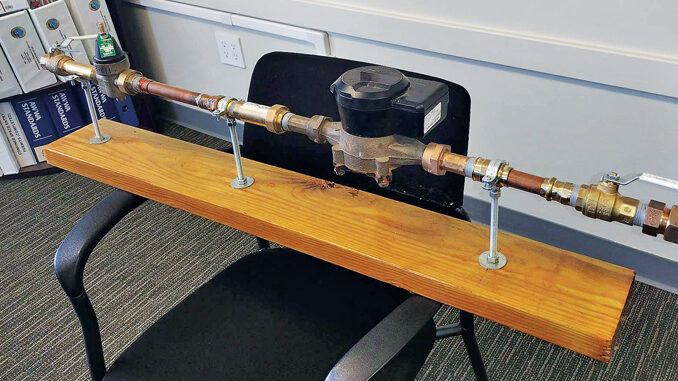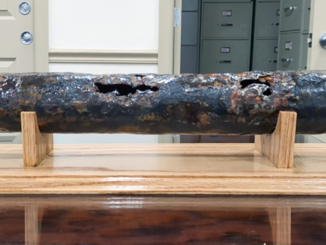
Superintendent needs residents’ assistance to report piping materials
The Water Department, which services the Town of Cornwall and the Village of Cornwall-on-Hudson, is undertaking a number of projects, some of which will require assistance from residents. Superintendent Michael Trainor provided details on four of the ongoing efforts to improve the system and conserve water.
Lead and copper piping
In 2021, the Environmental Protection Agency made revisions to the lead and copper rule for public water systems. The biggest change, said Trainor, is the department being required to inventory every water main connection of which there are approximately 2,600 between the town and village. An inventory is required both on the public side of the curb stop, between the main and the curb valve, and on the private side, between the curb valve and the house.
Trainor said there are a few ways to accomplish this goal. The first is by going through old records. For example, village code, going back to 1966, required copper water lines, so anything built starting in 1967 can be inventoried as copper. Prior to those records, however, will require either excavating lines or making an appointment to get inside homeowners’ residences to conduct a visual inspection.
Digging up a service line can get costly with each job costing a couple thousand dollars, but Trainor said residents can assist the department by conducting their own inspection and reporting it through the village’s website, cornwall-on-hudson.org. By clicking on “departments,” and scrolling down to “water,” residents can find the tab for “lead service lines.” There information can be found about lead lines and how to determine if a line is made of lead. A video will also help with the inspection. Residents can then fill out the self-inspection form which will get submitted to the Water Department.
Trainor said he’s never come across a lead line in his 30 years with the department. He also consulted with former Water Department Super-intendent Ralph Smith, who also reported never coming across one. While copper, brass, and plastic lines are okay, if no determination can be made, the assumption will be that the line is galvanized or made of lead until an absolute determination can be made. Any galvanized or lead service lines will need to be replaced either by the Water Department or the homeowner.
The inventory must be completed by Oct. 16, 2024.
Backflow regulations
Over the past few years, the department has been enforcing backflow regulations as set at the local, state, and federal levels.
“Backflow prevention is the ability to prevent water, once it leaves our water main and enters one’s property, it doesn’t come back into the water main,” Trainor said. “If there’s a water leak and water gets shut down, water can be siphoned out of properties back into the water mains.”
Trainor explained there are two common instances in which water could be siphoned back into the system without backflow precautions in place. If someone is filling their pool with a garden hose and there’s a water main break forcing the system to be shut down, water can be siphoned out of the pool. Now highly chlorinated water is entering the public water main. Lawn irrigation systems with submersible heads can also cause a problem. If there’s a break, fertilized water puddling around the heads could be siphoned back into the system.
In the mid-1990s, the village instituted a backflow prevention code which required any service line connected to the public water system to have backflow prevention. Commercial establishments like restaurants, government buildings, multifamily dwellings, and funeral homes are required to have a testable device designed by a licensed engineer and approved by the Orange County Department of Heath, as well as the Water Department. Single family residences can utilize a non-testable backflow device installed by a plumber.
Trainor said the code is being enforced. Site visits are being conducted of all commercial facilities, requiring these devices be installed if not already. Single family residences are not being forced to comply unless an owner is trying to sell their home or performs plumbing upgrades.
Water meters
The department is in the midst of a water meter upgrade project and Trainor anticipates the final 360 meters will be replaced this year. The older meters are being replaced with smart meters which will allow employees to conduct readings remotely. The meters are also able to detect leaks and will alert the department of any abnormal water consumption.
Since 2003, 2,100 meters have been replaced, but it wasn’t until 2020 that the infrastructure was installed at the hospital and the Cornwall-on-Hudson firehouse to allow the remote reading of the meters. The capital project has been spread out because replacing all the meters at once would have cost about $1 million. Trainor said the Water Department didn’t have the funding available due to other projects, but with a healthy fund balance, the project can be completed without having to borrow money or raise water rates.
While the newer meters are capable of recording water consumption to the tenth of a gallon, the older meters installed at the start of the project still record in 50-gallon increments. Trainor said those will eventually be replaced and all the meters will be replaced on a regular basis.
Trainor said the meter vendor, Neptune Technologies, is in the process of developing software which will allow residents to monitor their own meters. The hope is to have the program rolled out later this year. He said there will be no cost to residents.
eBills
About three years ago the village rolled out the ability for residents to receive paperless bills and pay their water bill online. Trainor said he’d like to continue pushing that option and encourages customers to visit the village’s webpage and click the link marked “pay my utility bill” located in the center of the home page. Instructions are provided. Trainor said there may be fees associated with paying online, but receiving a paperless bill and paying by check is still an option.
Through multiple efforts, from meter replacement to a vigorous leak detection program, water consumption has dropped considerably in the past seven years. From Sept. 5, 2015 through Sept. 1, 2016, Trainor reported 48.2 percent of water produced was unaccounted for. From Nov. 1, 2021 through Oct. 30, 2022, an average of 741,813 gallons of water was produced daily. Of that, 644,295 gallons were billed resulting in 13.15 percent of water being unaccounted for due to leaks. Trainor said according to industry standards, anything less than 15 percent is seen as a tight system. The national average is 35 percent.


